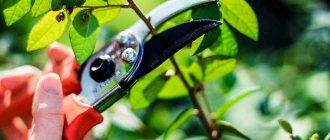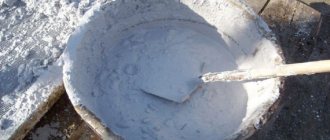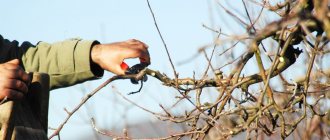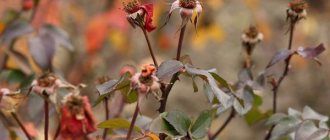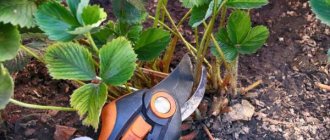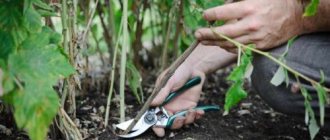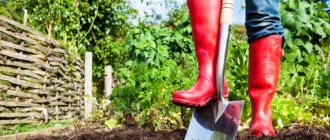Proper pruning of fruit trees is the basis of a beautiful, well-groomed, harvest-rich garden. Features of autumn haircuts, all the “dos” and “don’ts”, “how” and “when”, “why” and “why” - further in the article.
Autumn pruning of fruit trees is a procedure that is as necessary as a haircut for a person. The reasons for it can be completely different.
Some trees have become too overgrown over the summer, their “hair” needs ventilation, so they are thinned out.
Others have suffered from an infestation of pests, and only proper haircutting can help get rid of them completely.
Still others have been exposed to the aggressive effects of the elements, and all dry and broken branches need to be cut out.
The fourth ones have simply grown old, and proper pruning will help them renew themselves and begin bearing fruit with renewed vigor.
Each individual case has its own nuances and its own rules. But if you make a mistake, the tree will suffer and may not even survive until spring. Therefore, autumn haircuts should be approached responsibly and competently.
Attention!
When pruning, tools must be clean and well sharpened.
Timing for pruning trees in autumn
The autumn pruning procedure helps trees to withstand winter cold more easily, and also has a very positive effect on the quality characteristics of the future harvest. But it must be done on time.
Gardening activities begin when nutrients move from the leaves to the trunk and roots, that is, with the fall of the leaves. At this time, sap flow slows down, the tree is preparing to retire, and therefore is least susceptible to injury.
It is best to carry out operations to remove excess growth in September or October. Then the tree will have time to adapt to its new “look” even before the onset of frost and will survive the winter more easily.
In November, it is extremely undesirable to engage in them. After all, if frost hits, the bark in the cut areas will freeze, and the wood underneath will begin to shrink. As a rule, green space injured in this way ultimately dies.
Attention!
Autumn pruning of trees and shrubs is carried out exclusively in regions with a temperate climate. It is extremely undesirable to carry out such procedures in the northern regions: the plants do not have time to recover before the onset of frost.
Crown formation
In order for plants to produce a good harvest, it is important to form the correct crown by cutting out unnecessary twigs.
Which processes are removed:
- Dry, broken branches.
- Weak branches in the crown, as well as those growing at an acute angle to the trunk or upward.
Important! Every 3-3 years, replace the main fruiting branches in the crown area, preventing excess shoots from thickening it. Old-timers advise tying multi-colored ribbons to the branches, by which you will notice: which of them were strewn with apples, which did not have them, and which are still very young.
Pruning trees and shrubs in autumn, main principles
Attention!
Autumn pruning can only be done on winter-hardy varieties of fruit trees.
Basic principles of pruning
Most often, the gardener's autumn concerns come down to only sanitary pruning of trees. Everything else is postponed until the spring.
But sometimes it is advisable to perform other types of circumcision:
- shortening shoots on first-year plants;
- thinning the crown for better lighting and ventilation;
- its formation according to a predetermined contour;
- rejuvenation of trees.
The procedure is performed in the following order:
- First of all, they carry out sanitary pruning of branches that are diseased, withered, attacked by pests, and also broken due to bad weather or under the weight of the crop.
- Remove all tops and root shoots without exception.
- Next, they get rid of the weakest ones, those growing closely, directed towards the center or vertically upward, as well as branches rubbing against each other.
- In the case of anti-aging pruning, old and unpromising branches are removed.
- Wounds caused during the procedure are carefully treated. For this, garden varnish is most often used.
- All biomaterial obtained as a result of such processing is immediately removed to a considerable distance and must be burned.
Advice!
In the absence of garden varnish, you can use regular oil paint. Moreover, it is even preferable if the cuts are large or there is a high risk of rapid onset of cold weather.
The following figure will help you see in more detail which branches must be removed:
Features of pruning trees of various types and age groups
When pruning young trees, the removal of branches is insignificant. Its main purpose is to form a crown.
The following types are distinguished:
- longline with a central conductor (or leader);
- changed-leader;
- cup-shaped.
A tree that has already entered the fruiting stage needs more severe pruning. At the same time, some branches are cut out completely, while others are only shortened. Such measures allow you to increase the yield, as well as strengthen the structure of the crown so that the branches do not break under its weight.
Old trees need rejuvenating pruning. At the same time, more than half of the old, least productive and unable to provide proper nutrition branches are removed. After carrying out this procedure, the yield decreases slightly in the first year, but then the tree begins to bear fruit with renewed vigor.
Dwarf breeds also need pruning. But they grow much slower than usual. Therefore, you need to cut off much fewer branches from them.
As for shrubs, they wake up very early, so autumn pruning is much preferable to spring pruning for them. This procedure is not only a way to keep them in good condition. This is also an excellent opportunity for rejuvenation, as well as improving the quality characteristics of the crop.
Removing old branches stimulates the growth of young shoots. In addition, this creates conditions for better ventilation and penetration of sunlight. This means that the bush is less susceptible to attacks by various fungi, and the berries on it become sweeter.
Adviсe!
In most cases of fruit tree pruning, removing a few branches each year is much easier to handle than mass pruning of branches every few years.
As a rule, the number of branches cut should be approximately equal to last year's growth (but not more than a third of the crown).
First of all, old, unproductive branches are removed.
Pruning trees in autumn for beginners in pictures
When starting to trim trees, it is very important to navigate not only how to choose the right tools and time, but also what is the best technology to use to remove excess vegetation. But it is with the last point that novice gardeners most often have problems. The pictures presented here will help you better understand which elements of the tree should be cut first and what is the best way to do it.
branches subject to mandatory removal
Everyone knows that dry and diseased branches are cut out first. Then those that grow inside the crown or interfere with each other. Next, you need to look at the angle between the branch and the trunk.
The closer it is to zero (or 180 degrees, if the branches are directed downwards), the less these branches are predisposed to fruiting.
Therefore, experienced gardeners strive to leave (or form as such) the maximum possible number of branches growing perpendicular to the trunk. After all, it is on them that the largest part of the “fruits” are formed, which are the basis of the future harvest.
Advice!
If the frame branches grow incorrectly, it is not advisable to prune them. It is best to stretch such branches with a rope and secure them. After 2-3 weeks you can release them, or you can leave the tree in this state until spring.
Features of cutting branches
It is important not only to identify the branches needed to remove, but to cut them correctly. The following techniques are used:
Thin branches are cut using pruning shears; for thick ones, a saw is used. It is very important to leave as even cuts as possible on the tree, as well as to use the correct techniques for removing branches. Mistakes here are fraught with a decrease in yield, the development of diseases and even the death of the tree as a whole.
How to properly prune an apple tree in the fall, diagram
The apple tree is one of the most popular trees in our latitudes. Not everyone knows this, but it can bear fruit for about a hundred years. But you cannot do without proper care, one of the elements of which is proper pruning.
The scheme for its implementation depends on the age of the apple tree and can be carried out in one of the following ways:
- strong – removal of about 2/3 of the annual growth;
- medium (moderate) – cutting out about half of the growth of the shoot;
- weak - shortening of the shoot by 1/4-1/3 of the annual growth.
Together with them, thinning is also used, that is, cutting out entire shoots.
When formative pruning of young seedlings, light pruning is used with cutting out some shoots entirely. In this case, the central conductor should rise 15-30 cm above the other branches. Skeletal branches are formed from 3-5 lateral shoots, shortened to a bud and leaving their ends at the same level. All competitors are cut into a ring.
During the period of active fruiting (5-10 years), the main task of pruning is to activate the “fruits” and, accordingly, increase the yield. In this case, strong thinning is combined with weak (or medium) shortening. In this way, the density of the crown is regulated, as well as the growth and desired direction of overgrowing branches.
The video will help you better understand all of the above:
Older apple trees need rejuvenation. In this case, severe pruning of apple trees is used: the skeletal branches are cut to the area where the tops appear, and the crown is partially thinned out. The procedure improves the conditions for fruit ripening, which has a better effect on their quality. The branches that need pruning during rejuvenation pruning of old apple trees are perfectly illustrated by the diagram:
Blackberry
In autumn, shoots older than 2 years and young thin shoots are removed. Pruning is done at the root, after which the open areas are treated with drying oil or garden varnish. The tips of the branches, if they were not removed in the summer, are best left to winter, and with the arrival of warmer weather, shorten the frost-damaged tops to a bud.
In the fall, there should be 8 healthy shoots on the bush, with a diameter of more than 0.5 cm - in the spring their number will have to be reduced by another 1.5 - 2 times. The annual growth is shortened by 60–70 cm to enhance branching.
How to prune a pear tree in autumn
Like an apple tree, excess growth is also removed from a pear tree, which often naturally forms a well-shaped crown with a central conductor. Usually it is not as dense as that of an apple tree, so it needs similar, but less severe pruning. In addition, since the tree has a tendency to freeze in winter, it is pruned lightly.
But due to the fact that some of the active buds of the pear die, the sleeping ones awaken. And among them, a lot of tops always form, which the gardener must work on. By shortening such shoots are transformed into semi-skeletal and overgrowing branches. All others are removed so as not to interfere.
Attention!
According to experts, it is the autumn pruning of pears that brings the greatest benefit to the tree.
Only pears of early and medium varieties are processed in this way.
In the first year after planting, the seedling is not pruned.
How to prune a plum tree in the fall
Regarding autumn pruning of plums, expert opinions differ. Supporters complain that due to the vagaries of the weather in the spring, you simply may not have time to complete this procedure. Opponents appeal to the fact that mistakes made at this time can become fatal for the tree.
Indeed, autumn cuttings do not last well. The reason for this is a suspension in the growth of cambial cells. Based on the above, it is best to carry out only sanitary pruning of plum trees in the fall. When preparing a tree for winter, it is imperative to remove dry, diseased and broken branches from it, and in some cases also thin out the crown so that it is not injured by a large amount of snow.
For trees in the active fruiting phase, the procedure is carried out according to the following scheme:
Common Mistakes
When pruning, the following mistakes are often made:
- When cutting, the branch must be removed under the base so that there is no stump left, otherwise it will be overgrown with young shoots. Even if such a stump dries out and does not give life to new branches, then the bark slides off it, opening a wound that can cause disease and pest damage.
- When cutting down thick branches, care must be taken not to tear up the bark. To do this, large branches are cut off in parts, and the remaining piece is sawed off from below to prevent wounds.
- Pruning provokes the appearance of a large number of young shoots in the spring. It is extremely important to remove them immediately so that the sap is directed to the main branches that will bear a rich harvest.
How to prune currant bushes in autumn
All types of currants are pruned during the dormant period, when the bushes have neither leaves nor buds.
At the same time, no more than 10 large branches are left on young bushes. On those that have already begun to bear fruit, about a third of the oldest shoots are removed. This is done at the root, near the ground. By the way, in a similar way they get rid of unripe shoots, which, when frozen, significantly reduce the immunity of the plant as a whole. The remaining branches, for better branching, are shortened to the first bud.
Black currant branches bear fruit best at 3-5 years, and white and red ones at 2-5 years. Then they gradually lose productivity. Therefore, all aged branches must be removed. But at the same time, you definitely need to take care of new ones, leaving 3-5 mature replacement shoots every year.
Adviсe!
After removing the shoots from the currant bushes, they need hilling. After all, new branches must sprout from the roots.
Everything that concerns pruning red and white currants can also be applied to gooseberries.
Raspberries
Autumn pruning of raspberries is necessary to maintain high yields. In the middle zone, work begins in the second half of October. First of all, three-year-old shoots that are no longer suitable for bearing fruit are removed with sharp pruning shears. They are easily recognized by their brown, very rough, sometimes receding bark. The stems are cut close to the ground, trying not to leave stumps.
There is no point in keeping thin young growth in the root zone - it will still freeze from the cold. We need only one- and two-year-old shoots with a trunk diameter of at least 0.5 cm. They will definitely produce a harvest next year. To prevent the berries from becoming smaller, the shoots are cut to a height of 110 cm, trying to install the pruning shears above the bud - in the internode.
Cuttings are used as covering material for strawberries or flowers planted before winter. And from thin branches you can brew healing tea.
What's the best way to prune grapes in the fall?
Autumn pruning of grapes is one of the mandatory procedures for this crop. At first glance, the operation is quite complicated, but if it is neglected, the plant will devote all its energy to forming a vine, and then you will simply have to forget about the harvest. Therefore, every beginning winegrower simply needs to master it.
They begin to form a grape bush only after it has completely gotten rid of foliage, but before the onset of persistent cold weather. For good yield and early fruiting, immediately after planting, two main shoots are formed on the grapes.
In the second year of life, in order for the seedling to gain strength, it is shortened by two buds, and in the summer the excess is pinched off. In the third year, removing all unnecessary branches, the fruit link is finally formed: sleeve-knot of replacement-vine of fruiting.
Attention!
The length of pruning vines for each variety is different and depends on its characteristics: short - for 4 buds, medium - for 4-8 and long - for 8-12, and sometimes up to 20 buds (by the way, the first two can be ignored).
When performing the procedure, all cuts left on each of the sleeves must be on one side. Otherwise, circular tissue necrosis may occur, which will lead to the death of the plant.
The formation of a grape bush in the first two years of life is as follows:
In general, starting from the third year, the scheme for autumn pruning of grapes looks something like this:
- All fruit-bearing vines, tops, as well as weak and interfering shoots are cut off.
- All unnecessary branches are removed from young bushes, and annual branches from old ones.
- Fruiting vines are shortened depending on the individual characteristics of the variety. Replacement knots - 3-4 buds.
Adviсe!
Without knowing exactly what variety you are pruning, in order to accurately get into the fruiting zone, it is best to prune by 6-8 buds.
The weaker the shoot, the fewer buds are left on it.
Top shoots are cut out both completely and for replacement knots.
When pruning in autumn, it is advisable to leave 2-3 times more shoots than necessary. This is due to the possibility of them freezing. In the spring, everything unnecessary must be removed.
Gooseberry
In the spring, the crop begins its growing season early, so it is better to prune in the fall. Remove the lowest branches and those that thicken the crown by getting tangled with each other. With large shading, gooseberries are affected by powdery mildew. The bush also does not need old shoots that have reached the age of five, are weak or diseased. The tops of strong, healthy branches are trimmed so that they bush better.
Is it necessary to whiten trees in the fall?
For experienced gardeners, the answer will definitely be positive. And the main reason here is far from aesthetic appeal, which is often used to motivate spring whitewashing. The fact is that this procedure helps the tree to more easily tolerate sudden temperature changes, and, accordingly, to emerge from hibernation with fewer losses.
Otherwise, gardeners have to deal with frost cracks. These wood lesions most often occur at the very end of winter, when the sun is already shining with all its might during the day, and frost returns again at night. Such crevices practically do not heal on their own. They need to be treated long and hard. If this is not done, the tree weakens and eventually dies.
Contrary to popular belief, trees of all age groups without exception need to be whitewashed. But in the case of young seedlings, it is necessary to avoid solutions containing lime or limit its amount in whitewash mixtures as much as possible. Regarding old trees, the painting process becomes much more complicated due to the large amount of pre-painting work.
Advice!
It is advisable to carry out painting work just before frost, so that such a coating lasts as long as possible on the tree trunk.
The trunk and skeletal branches are subject to painting. Moreover, the higher the tree is whitewashed, the better.
High whitewashing of the garden is most conveniently done using a sprayer.
What to do if the leaves have not fallen
Often fruit trees are left with leaves. There are many reasons, including excessive watering, excessive fertilizing and various diseases.
What to do? Nothing yet! We can only hope for a mild, snowy winter. Just don’t prune, much less pick off the remaining foliage. If you can cover it, then cover it, and next season find the reason for this behavior of the plants.
This kind of work can be done. After light frost, cover the tree trunk circles with a thick layer of mulch from coniferous needles, peat, grass or dry leaves. And wrap the trunk of the apple tree right up to the crown with covering material. Young seedlings should be covered to the very top.
How to whiten trees in the fall
For autumn painting of trees, various mixtures are used: water-based paint, water-dispersion paint, as well as well-known lime solutions. The main requirements for whitewashing compositions are painting the surface white, allowing the skin to “breathe” underneath, and also the duration of stay on the bark.
Modern industry offers a wide range of whitewashes for trees. But you can also cook them yourself. In this case, the composition used for coloring should include the following components:
- white clay, lime or chalk - to give it a white color;
- glue, milk or soap - for better adhesion to the bark;
- fungicide – for disinfection.
Attention!
When using purchased paint, be sure to make sure that it is intended specifically for whitewashing living trees and not for any other wood.
But the whitewashing itself is only the final step in a four-step process. It is preceded by cleaning the trunk, its disinfection, as well as healing of wounds.
Disinfection of wounds
Pruning branches should not be taken in isolation from subsequent disinfection. In addition to covering the wounds of plants with the help of the compositions that we have already talked about earlier, they must be protected from the attacks of various infections. There are many recipes for such disinfectant compositions, the most effective of which are presented below:
- Fifty grams of copper sulfate are diluted in one liter of hot water;
- A few drops of potassium permanganate are diluted in water until a rich pink hue is obtained;
Potassium permanganate kills all kinds of pathogenic bacteria before they have time to penetrate the tree
Prices for copper sulfate
copper sulfate
Preparation of Bordeaux mixture
Important! To apply disinfectant compounds, you should select a quiet, windless day without precipitation in advance. When distributing the mixture, be sure to use protective gloves to avoid burning your hands in case of accidental contact with the product.
